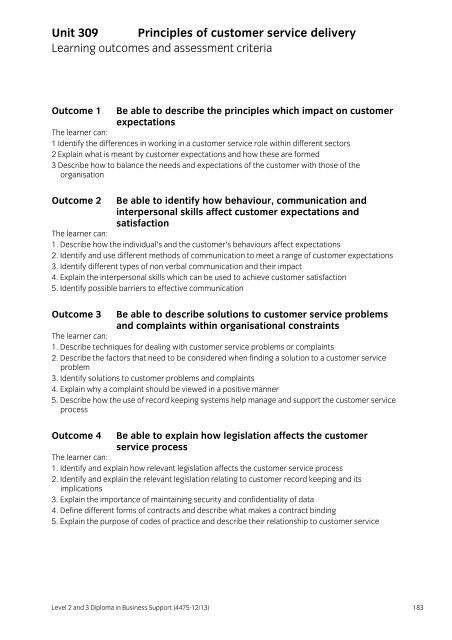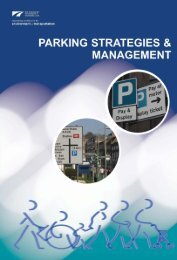Level 2 and 3 Diploma in Business Support (4475-12/13)
Level 2 and 3 Diploma in Business Support (4475-12/13)
Level 2 and 3 Diploma in Business Support (4475-12/13)
You also want an ePaper? Increase the reach of your titles
YUMPU automatically turns print PDFs into web optimized ePapers that Google loves.
Unit 309 Pr<strong>in</strong>ciples of customer service delivery<br />
Learn<strong>in</strong>g outcomes <strong>and</strong> assessment criteria<br />
Outcome 1 Be able to describe the pr<strong>in</strong>ciples which impact on customer<br />
expectations<br />
The learner can:<br />
1 Identify the differences <strong>in</strong> work<strong>in</strong>g <strong>in</strong> a customer service role with<strong>in</strong> different sectors<br />
2 Expla<strong>in</strong> what is meant by customer expectations <strong>and</strong> how these are formed<br />
3 Describe how to balance the needs <strong>and</strong> expectations of the customer with those of the<br />
organisation<br />
Outcome 2 Be able to identify how behaviour, communication <strong>and</strong><br />
<strong>in</strong>terpersonal skills affect customer expectations <strong>and</strong><br />
satisfaction<br />
The learner can:<br />
1. Describe how the <strong>in</strong>dividual’s <strong>and</strong> the customer’s behaviours affect expectations<br />
2. Identify <strong>and</strong> use different methods of communication to meet a range of customer expectations<br />
3. Identify different types of non verbal communication <strong>and</strong> their impact<br />
4. Expla<strong>in</strong> the <strong>in</strong>terpersonal skills which can be used to achieve customer satisfaction<br />
5. Identify possible barriers to effective communication<br />
Outcome 3 Be able to describe solutions to customer service problems<br />
<strong>and</strong> compla<strong>in</strong>ts with<strong>in</strong> organisational constra<strong>in</strong>ts<br />
The learner can:<br />
1. Describe techniques for deal<strong>in</strong>g with customer service problems or compla<strong>in</strong>ts<br />
2. Describe the factors that need to be considered when f<strong>in</strong>d<strong>in</strong>g a solution to a customer service<br />
problem<br />
3. Identify solutions to customer problems <strong>and</strong> compla<strong>in</strong>ts<br />
4. Expla<strong>in</strong> why a compla<strong>in</strong>t should be viewed <strong>in</strong> a positive manner<br />
5. Describe how the use of record keep<strong>in</strong>g systems help manage <strong>and</strong> support the customer service<br />
process<br />
Outcome 4 Be able to expla<strong>in</strong> how legislation affects the customer<br />
service process<br />
The learner can:<br />
1. Identify <strong>and</strong> expla<strong>in</strong> how relevant legislation affects the customer service process<br />
2. Identify <strong>and</strong> expla<strong>in</strong> the relevant legislation relat<strong>in</strong>g to customer record keep<strong>in</strong>g <strong>and</strong> its<br />
implications<br />
3. Expla<strong>in</strong> the importance of ma<strong>in</strong>ta<strong>in</strong><strong>in</strong>g security <strong>and</strong> confidentiality of data<br />
4. Def<strong>in</strong>e different forms of contracts <strong>and</strong> describe what makes a contract b<strong>in</strong>d<strong>in</strong>g<br />
5. Expla<strong>in</strong> the purpose of codes of practice <strong>and</strong> describe their relationship to customer service<br />
<strong>Level</strong> 2 <strong>and</strong> 3 <strong>Diploma</strong> <strong>in</strong> Bus<strong>in</strong>ess <strong>Support</strong> (<strong>4475</strong>-<strong>12</strong>/<strong>13</strong>) 183







